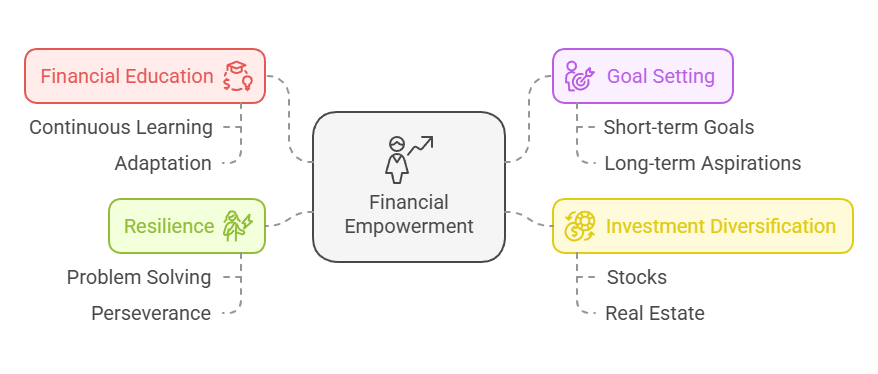Women entrepreneurs comprise approximately 20% of all enterprises in India, with estimates suggesting there are between 13.5 million to 15.7 million women-owned businesses. These businesses employ around 22 to 27 million people, highlighting their crucial role in the economy.
The entrepreneurial spirit thrives among Indian women, with a growing number venturing into business ownership.
However, achieving financial freedom extends beyond business success. It requires a proactive approach to wealth building, encompassing savings, investments, and astute financial planning.
A recent survey revealed that over 90% of working women contribute to household expenses, with nearly 40% contributing more than 50% of their income. Source
Despite this significant contribution, around 70% of these women earn less than INR 5 lakh annually, while only 23% fall within the INR 5-10 lakh income bracket1.
This income disparity reflects broader issues related to access to opportunities and resources for women entrepreneurs.
1. The Foundation: Financial Education
- Embrace Continuous Learning: Engage in online courses, read financial books and articles, attend seminars, and stay abreast of market trends through reputable news sources.
- Seek Expert Opinions: Consult with financial advisors to gain personalized insights and guidance tailored to your specific needs and risk tolerance.
- Leverage Online Resources: Utilize online platforms and tools that offer educational resources, investment calculators, and portfolio tracking features.
2. Set Clear Financial Goals: A Roadmap to Success
- Prioritize Short-Term Goals: Establish an emergency fund to cover unforeseen expenses.
- Focus on Long-Term Aspirations: Plan for retirement savings, fund your children’s education, or invest in a dream property.
- Break Down Large Goals: Divide ambitious targets into smaller, more manageable milestones to maintain motivation and track progress.
- Visualize Your Financial Future: Create a vision board or a financial plan to visualize your desired outcomes and stay motivated.
3. Diversification: Spreading Your Wings
- Explore a Range of Asset Classes: Invest in a mix of equities (stocks), debt instruments (bonds), real estate, gold, and other asset classes.
- Consider Mutual Funds and ETFs: These offer diversified exposure to a basket of securities, providing a convenient and cost-effective investment option.
- Invest in Your Business: Re-invest profits back into your business for growth and expansion.
4. Understand Your Risk Tolerance: Navigating the Investment Landscape
- Assess Your Comfort Level: Evaluate your financial situation, investment horizon, and emotional response to market fluctuations.
- Align Investments with Risk Profile: Choose investment options that align with your risk tolerance. Conservative investors may prefer low-risk options, while those with higher risk tolerance can explore more aggressive investment avenues.
- Regularly Re-evaluate Your Risk Tolerance: As your financial situation and life circumstances change, reassess your risk tolerance and adjust your investment portfolio accordingly.
5. Regularly Review and Adjust: Stay on Course
Consistent monitoring and adjustments are crucial for achieving financial goals.
- Conduct Regular Portfolio Reviews: Review your investment portfolio at least quarterly or annually to assess its performance and make necessary adjustments.
- Stay Informed About Market Trends: Keep abreast of market developments and economic news that may impact your investments.
- Rebalance Your Portfolio: Periodically rebalance your portfolio to maintain your desired asset allocation and ensure that your investments remain aligned with your risk tolerance and financial goals.
6. How to Overcome Barriers: Empower Women Entrepreneurs
- Build Confidence and Overcome Self-Doubt: Embrace your entrepreneurial journey, believe in your abilities, and seek support from mentors and other women entrepreneurs.
- Challenge Societal Norms: Break free from societal expectations and pursue your financial goals with determination and resilience.
- Leverage Support Networks: Connect with other women entrepreneurs through networking events, online communities, and support groups.
- Prioritize Self-Care: Maintain a healthy work-life balance, prioritize self-care, and seek support from family and friends.

7. How to Achieve Financial Freedom in India: Key Strategies
- Embrace Financial Literacy: Prioritize continuous learning about financial markets, investment products, and tax laws.
- Set Ambitious Yet Achievable Goals: Define clear and measurable financial goals that align with your aspirations.
- Diversify Your Investment Portfolio: Build a balanced portfolio that includes a mix of equity, debt, and other asset classes.
- Seek Professional Guidance: Consult with qualified financial advisors for personalized advice and guidance.
- Embrace Technology: Utilize online platforms and tools to manage your finances, track investments, and access financial information.
Related Post
Financial Empowerment Guide: Build Wealth and Secure Financial Independence
By implementing the strategies of this financial empowerment guide and maintaining a proactive approach to financial planning, women entrepreneurs can build wealth, secure their financial independence, and achieve their long-term financial aspirations.
Remember, financial freedom is not a destination, but a journey that requires continuous learning, adaptation, and perseverance.
Now go out there and turn your vision into reality!











